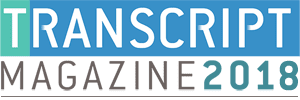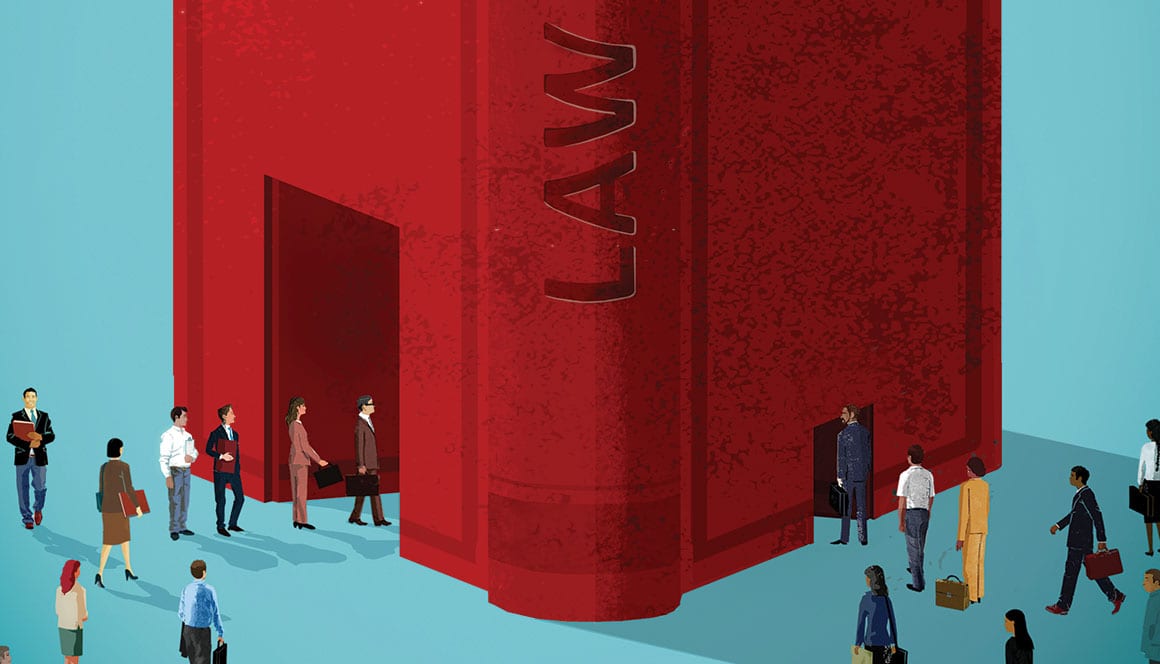
Berkeley Law’s wide-ranging racial justice work confronts inequities throughout the legal system.
By Andrew Cohen
The racial justice work churning within Berkeley Law is expansive and inspiring. Yet the people leading that work—clinic leaders, student advocates, faculty scholars—acknowledge that confronting racial inequities in America demands confronting them in its legal institutions.
“Racial justice work is disingenuous unless it’s connected to that acknowledgment,” says Tirien Steinbach ’99, director of Berkeley Law’s East Bay Community Law Center (ECBLC). “People talk about leveling the playing field, but very few legal entities actually do it.”
Across the board, the data is damning. In California, people from racial-ethnic groups account for more than 60 percent of the population but less than 20 percent of the lawyers. Nationally, minorities make up just 9 percent of law firm partners. Only 11 percent of Fortune 500 general counsels are African American, Hispanic, Asian, or Native American.
Minorities are also underrepresented as judges and prosecutors. According to a recent study, whites comprise 83 percent of state judges and 81 percent of assistant U.S. attorneys. Asian Americans make up 10 percent of graduates in top U.S. law schools, but only 2 percent of state judges.
Judicial clerkships further reflect that imbalance. Whites made up 58 percent of the students at Top 30 law schools in 2015, but 82 percent of federal clerks. African Americans comprised just 4 percent.
“These extreme racial disparities both derive from and create racial injustice,” says Savala Trepczynski ’11, executive director of Berkeley Law’s Thelton E. Henderson Center for Social Justice. “They’re part of a cycle. Who ends up in our profession—and at the top of it—has a lot to do with who lives in well-resourced, free communities and who doesn’t.”
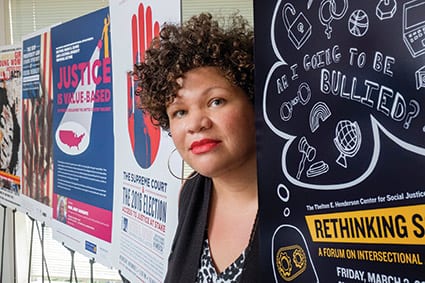
She adds that, “When the power brokers almost exclusively mirror and are connected to those same well-served communities, we reproduce the very dynamics that created the original inequities. All law schools need to ask themselves if they’re inadvertently contributing to the problem or advancing the solution.”
Juvenile system figures foretell how such inequities eventually play out. According to 2016 California Department of Justice data, African-American youth are far more likely than white youth to be arrested (4.4 times), detained (7.6), given probation (3.3), removed from their family’s home (4.4), and moved to adult court (5.9).
At a November criminal justice conference co-sponsored by Berkeley Law and the Heritage Foundation, Dean Erwin Chemerinsky noted that, “Every study shows how a black or brown person is more likely to get stopped than a white person, more likely to be arrested, and more likely to be charged with a longer sentence.”
Indeed, images of “white supremacy” are shifting from Ku Klux Klan rallies to institutional entrenchment—from racial profiling, gerrymandering, and workplace discrimination to racial imbalances within law schools, firms, and courts.
“It’s clear that the problem of continued racism is not about a few bad-acting, self-declared white supremists, but a culture of white supremacy that privileges whiteness—individually, interpersonally, institutionally—in ways that often block access and opportunity for people of color,” Steinbach says.
CREATING A HUB
The Henderson Center—the only student-focused center dedicated to racial justice among top-tier law schools—anchors Berkeley Law’s work in this area. The center examines race and issues that implicate it: class, reproductive justice, immigration, civil rights, and more.
That involves lectures, workshops, scholarship, conferences, and community-building events. The center also facilitates practical training and mentorship for students, and develops research that touches on race, poverty, bias, and related areas.
The school just launched a new endowed fellowship, funded by two dozen sponsors, in honor of Judge Thelton Henderson ’62. Starting next year, it will provide summer employment funding for exceptional students to engage in otherwise unpaid racial justice internships.
Clinics, faculty, and students have long produced meaningful work in this arena. Until recently, however, it was often siloed. But with Chemerinsky, Steinbach, Trepczynski, and others eager to maximize the school’s collective efforts, a push to coordinate better has emerged.
“It’s very important for people who work on racial justice to collaborate,” says Professor Leti Volpp, who directs UC Berkeley’s Center for Race and Gender. “We each focus on one part of a much larger picture. Working in coalition enables us to make connections among issues that would otherwise go unnoticed.”
Toward that end, Berkeley Law is launching a new Race and Law Certificate, conceived and administered by the Henderson Center, this fall. To earn it, students must complete three courses in a designated curriculum, do field work, write a substantial paper, and attend Henderson Center programs.
“This can make our whole greater than the sum of its parts,” Trepczynski says. “We should be a hub for racial justice work, and this will help make that happen.”
Trepczynski and others hope the certificate can help Berkeley Law solidify its reputation on racial justice issues, create a sense of community in the school among those tackling them, and prepare students to work on problems deeply influenced by race and racism.
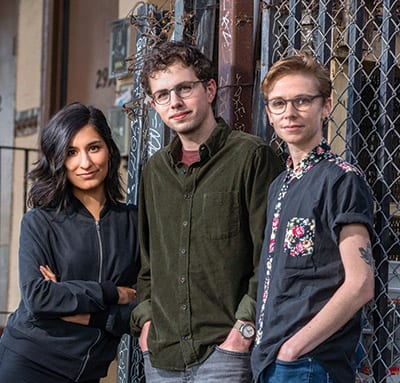
“It’s not just that students—from a variety of backgrounds—want to study that area,” says Kristin Theis-Alvarez, assistant dean of admissions and financial aid. “They do, but it’s more than that. The certificate signals that Berkeley Law invests in research and advocacy that directly connects with the experiences of underrepresented racial minorities, the communities from which we came, and the issues that we face daily.”
In that spirit, the school recently joined Pathway to Law, a state initiative aimed at diversifying the legal profession. Pathway’s goal is to funnel more underrepresented students toward law school and law-related careers.
“It’s important to recruit students … who come from immigrant, low-income, or other non-traditional backgrounds,” says former community college student Deborah Choi ’20. “A lot of these perspectives aren’t adequately represented in law schools, and the legal profession would benefit immensely by growing their presence.”
That ethos drives Berkeley Law’s Culture, Diversity, & Intergroup Relations Lab. Led by Professor Victoria Plaut, it provides trainings and community workshops to help schools, firms, and other organizations eager to increase diversity and inclusion. Students conduct experiments, surveys, and other research in areas such as perceptions of immigrants and police views of “suspicious behavior.”
WALKING THE WALK
Racial justice weaves through every unit at EBCLC, Alameda County’s largest provider of free legal services to low-income residents. For Steinbach, valuing her client base means reflecting it: her staff is 65 percent people of color and more than 50 percent first-generation U.S. citizen.
“Equity and inclusion demands that,” she says. “We want to ensure that all voices are heard in guiding the direction of our work.”
Students at EBCLC’s Clean Slate Practice strive to remove employment and civic barriers for people with criminal records. A recent Clean Slate report showed stark racial disparities in California driver’s license suspensions and arrests related to unpaid traffic fines and fees, and how racial bias in state policing and courts fuels poverty, homelessness, and family instability.
At EBCLC’s Education Defense and Youth Justice Practice, students work to decriminalize local public schools and stop the school-to-prison pipeline. They partner with public defenders to help youth arrested at school who face criminal charges and expulsion—identifying learning needs often overlooked by schools, consulting with administrators and teachers, and appearing in court.
Trevor Kosmo ’19 sees the negative impact of “harsh probation and school expulsion systems that discount the ongoing effects of childhood trauma and disability. Together, these systems set up young people for failure, disproportionately funneling youth of color into the larger criminal justice system and ultimately expanding incarceration.”
Working to interrupt this process, he says, reinforces “the importance of centering my career around racial justice.”
Fellow Youth Defender Clinic student Taylor Horn ’19 says many clients facing school expulsion have to move frequently to stay ahead of rising rents.
“Gentrification disproportionately displaces communities of color, and students of color are disproportionately expelled from schools,” he laments. The moves make it harder, he says, to develop relationships with peers, teachers, and administrators. “As a result, students of color are less likely to receive the benefit of the doubt than peers who are more embedded in the school community.”
That dynamic played out with two clients who faced expulsion—one Hispanic and the other African American—both of whom had regularly changed apartments and schools. “In both cases, it was hard to find teachers who could serve as positive character witnesses in their expulsion hearing,” Horn says. “That was heartbreaking.”
OTHER CLINICS DIG IN
Meanwhile, the Policy Advocacy Clinic has made a huge impact on another issue that strikes low-income families of color particularly hard: juvenile justice fines and fees. The clinic became a national catalyst in this area with reports that showed the costs are harmful, unlawful, and costly.
California counties charged families for detention in juvenile hall, legal counsel, electronic ankle monitoring, probation supervision, drug testing, and investigation reports, student research revealed. When families could not afford to pay, the debts became permanent legal judgments—leading to wage garnishment, bank account levies, and tax intercepts.
Because of the clinic’s work, several California counties now ban these fees, and lawmakers passed a bill to repeal them statewide. Thousands of low-income families have been relieved of $200 million-plus in past assessed fees, with more to come as counties end their collection practices.
PAC, which co-hosted a national convening on the topic in February, is working to ensure the bill is implemented throughout California and helping launch a #DebtFreeJustice campaign and website to serve as a resource hub on the issue.
Racial justice is also front and center at the International Human Rights Law Clinic. The clinic has initiated litigation (led by Associate Director Roxanna Altholz ’99) on behalf of the family of Anastasio Hernández Rojas, a longtime resident of San Diego and father of five. Deported to Mexico in 2010, Hernández Rojas tried to reunite with his family later that year but died after being beaten and tased by Customs and Border Protection agents at the U.S.-Mexico border.
The clinic’s claims before the Inter-American Commission on Human Rights allege that the U.S. violated international human rights law by not effectively investigating and prosecuting the perpetrators.
Although agents have killed at least 50 migrants and U.S. citizens along the border since 2010, no criminal or civil court has held an agent accountable for an unlawful killing. The clinic documents abuse by agents, elevates egregious cases in the media, seeks justice for the aggrieved, and works to improve agent oversight and accountability.
Altholz is also conducting a study in Oakland, where more than 70 percent of murders go unsolved and more than 80 percent of victims are African American. “The study explores the lived experience of the family members of unsolved murders by documenting their access to services, priorities, and views of law enforcement,” she says.
STUDENT INITIATIVE
Student-led projects address various racial justice issues ranging from immigration (see page 14) to parole. At the Tenants’ Rights Workshop, for example, students hold weekly clinics to help keep low-income communities of color in their East Bay homes.
Oakland’s African-American population is down 30 percent since 2000, in large part because of soaring housing costs and other economic pressures. “Affordable housing has begun to disappear into a void of high market rates,” says Co-director Nirali Beri ’19. “Because state law doesn’t allow local governments to control rent when a vacancy occurs, landlords have incentive to create vacancies through various and sometimes illegal means.”
For fellow co-director Ary Smith ’19, working with housing clients reaffirms “some of the reasons I came to law school: to understand the legal and political structures that produce racial inequities … and to develop concrete skills at intervening and supporting clients.”
The Law Students of African Descent (LSAD) is one of several student organizations to confront race issues. In recent months, the group sent letters to campus leadership about the racial impact of UC Police Department safety alerts, co-sponsored a Berkeley Law event on rethinking school discipline, and met regularly with the school’s Equity and Inclusion Committee.
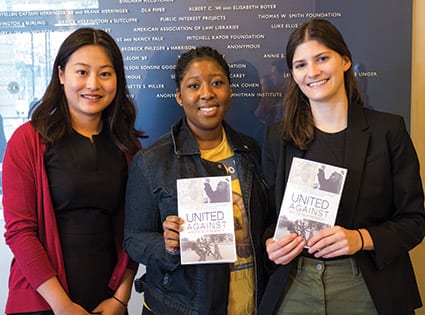
“We’re at a point in history where racial issues are at the forefront again, which is amazing to see,” says LSAD Co-Chair Alycia Tulloch ’19. With a growing number of students confronting these issues, she adds, “It’s been gratifying to see so many groups coming together in the name of racial justice. While LSAD can and should be at the forefront of the issues facing the Black community at Berkeley Law and in general, having support from allies is powerful.”
In February, four student journals sponsored a daylong “United Against White Supremacy” symposium. Participants examined how white supremacy permeates our legal system and probed strategies to dismantle inequities in gentrification, affirmative action, immigration, and incarceration.
While discussing potential collaborations, Middle Eastern Law Students Association Co-chair Monica Ramsy ’19 and South Asian Law Students Association Co-chair Joth Bhullar ’19 broached anti-black racism in other ethnic minority communities. That led to a January event called “Confronting Habits of Whiteness.”
“We wanted to help provide strategies for non-black students of color to identify, navigate, and ultimately resist the practices of this racism in our respective communities,” says Ramsy, who also co-chairs the Women of Color Collective.
Ramsy, fellow event organizer Zainab Ramahi ’19, and others are developing a set of materials from which students may draw resources needed to address racism.
For Ramahi, equity and inclusion chair of Berkeley Law’s Coalition for Diversity, this serves the school’s public mission. “Berkeley Law has historically been on the forefront of this kind of work,” she says. “So as Berkeley Law students, we believe it’s imperative that we continue this legacy.”
